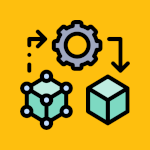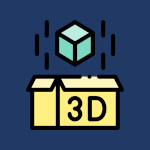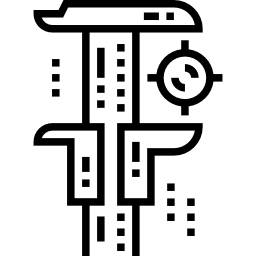3D printing with SLA technology
SLA Services:
- Excellent detail accuracy
- Large selection of colors
- Production from 7 working days

Start 3D printing
STEP | STP | SLDPRT | STL | IPT | 3DXML | CATPART | PTC | PRT | SAT
All downloads are secure and private
3D printing services with SLA technology
3D printing using the SLA (Stereolithography) technology is one of the first and most accurate additive manufacturing technologies. A light-sensitive photopolymer is used as the starting material for printing, which has a consistency similar to liquid resin. When the laser is exposed to the photopolymer, the exposed layer solidifies. This process is called photopolymerization. Thus, layer by layer, a physical object is formed. This process allows the production of products with high resolution (the layers of printed material are indistinguishable to the naked eye) and possessing isotropic and waterproof properties.
For 3D printing, a digital 3D model is mandatory, which is placed in a special program in the STL or OBJ format, and is sliced into layers in the most suitable way. The process of preparing the model for printing is called “slicing,” which generates G-code, a programming language for devices with numerical program control (CNC), which in this case is a 3D printer.
SLA 3D printing allows for high accuracy and surface quality compared to alternative technologies such as FDM. If you require a highly detailed part of small size, SLA 3D printing is suitable for you.
Let's try it now by following few steps

1. Upload CAD files
To get started, simply upload your 3D/CAD file
We can accept the following files:
- SolidWorks (.sldprt)
- ProE (.prt)
- IGES (.igs)
- STEP (.stp)
- ACIS (.sat)
- Parasolid (.x_t or .x_b)
- .stl files

2. Choose a process
First, select the required manufacturing process. Your project will be analyzed by engineers.
Within a few hours, we will send you a Manufacturability Analysis Report (DFM) for the part and the price in real time.

3. Order your parts online
Once you have reviewed your offer and placed an order, paying for it on the secure payment platform and we will begin the production process.

4. Get your parts
During the agreed period of time, you will receive the ordered parts. You can track your package at any time in your personal account, and also check the status of other orders.
Advantages of SLA

Fast production
Products can be manufactured and shipped in just 7 days, which reduces design time and accelerates the product launch process.

Accuracy
Possibility to obtain high-precision tolerances up to 0.15 mm

Fast delivery
We deliver parts in Ukraine, as well as anywhere in Europe. You can choose different delivery options that are convenient for you

High detail
The ability to produce an object with a layer thickness of up to 25 microns and a resolution of 2560 x 1440 dpi

Quality control
Our Quality Assurance department maintains strict quality control. Our measurement laboratory is certified to the ISO 9001 standard
3D printing services with SLA technology - Materials
- Standard
- Industrial (not subject to changes in the range from -45 ˚С to +225 ˚С)
- Enhanced strength (mechanical properties such as injection molding ABS)
- Dental (heat resistant)
- Burnout (for the production of investment casting molds)
- Injection molding (for printing very small parts and producing precise templates for vacuum casting)
- Engineering (Viscosity: 440 cPs, Shore D:86)
- Rubber-like (for elastic products)
Surface finish options after 3D-printing
The support material is removed and the parts are cleaned.
Additional processing and finishing on request.
3D printing services with SLA technology - Advantages and disadvantages
Advantages
Accuracy: the most precise and accessible 3D printing technology on the market
Quality: parts are made with high detail with a layer thickness of 25 microns, small details, and complex geometric shapes
Smoothness: the surface of the printed parts is virtually indistinguishable from those obtained by injection molding in terms of roughness
Disadvantages
Long printing time: printing relatively large items takes several times longer compared to FDM and HP MJF technologies
Presence of supports: overhanging elements require supports similar to FDM technology. These elements tend to break at various stages of printing and during hardening process
Printing cost: the cost of materials, printing time, and the need for additional processing of printed products (cleaning, UV oven processing) significantly affect the production time and the price of the finished product
Characteristics and capabilities of SLA printing technology
MJF
FDM
SLA
Lead time
3 days
5 days
7 days
Print volume
380 x 270 x 380 mm
500 х 500 х 500 mm
300 х 298 х 245 mm
Minimum layer thickness
~0,08 mm
~0,05-0,3 mm
0,025 mm
Minimum object size
0,5 mm
10 mm
0,2 mm
Tolerances
±0,3% (±0,2 mm)
±0,5% (±0,5 mm)
±0,5% (±0,15 mm)
Description
A technology that allows the production of highly accurate and durable parts at high print speeds, especially when compared to other powder bed printing technologies.
Widely known for its large selection of materials, precision and ability to print large parts.
A technology that allows the production of extremely precise, high-resolution parts.
Gallery of parts printed using SLA technology




Resources on 3D printing using the SLA method
Order 3D printing online
CNC machine tools online:
500+
3D printers online:
100+
All downloads are secure and private

































